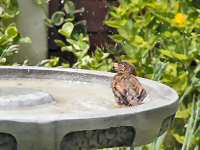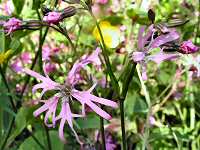| Features: Wildlife Trust Articles |  |
The magic of water Frog in a garden pond.
Of all the things you can do make your garden more attractive to wildlife, there is one that virtually guarantees success: adding some water. Frog in a garden pond.
Of all the things you can do make your garden more attractive to wildlife, there is one that virtually guarantees success: adding some water.  even animals which do not live in water are irresistibly drawn to it even animals which do not live in water are irresistibly drawn to it All animals require access to water. Some animals, for example daphnia and water snails, complete their whole life-cycles in water; while others, like damselflies and frogs, spend part of their lives in it. But even animals which do not live in water are irresistibly drawn to it; birds, for instance, must have regular access to water for drinking and bathing. By providing water in your own garden, you are enriching the habitat and making it a place where more animals will want to come. All animals require access to water. Some animals, for example daphnia and water snails, complete their whole life-cycles in water; while others, like damselflies and frogs, spend part of their lives in it. But even animals which do not live in water are irresistibly drawn to it; birds, for instance, must have regular access to water for drinking and bathing. By providing water in your own garden, you are enriching the habitat and making it a place where more animals will want to come.
Small can be beautiful Female house sparrow in a bird bath.
You don't need a big project to bring water into your garden: you can do it on a scale to suit the size of your garden, and your pocket too! Female house sparrow in a bird bath.
You don't need a big project to bring water into your garden: you can do it on a scale to suit the size of your garden, and your pocket too!  A bird bath alone will increase the wildlife interest of your garden immeasurably A bird bath alone will increase the wildlife interest of your garden immeasurably A bird bath alone will increase the wildlife interest of your garden immeasurably. If you don't want to buy one, you can make one, for example by supporting an upturned dustbin lid on the ground and filling it with an inch or two of water: the gently shelving sides make an ideal platform for birds which like to introduce themselves into the water gradually. A bird bath alone will increase the wildlife interest of your garden immeasurably. If you don't want to buy one, you can make one, for example by supporting an upturned dustbin lid on the ground and filling it with an inch or two of water: the gently shelving sides make an ideal platform for birds which like to introduce themselves into the water gradually.
 Ragged robin likes the damp areas around a water feature.
For a slightly more ambitious (though still cheap) project, you could sink and old trough, bowl, sink or other container into the ground so that the top is flush with the surface. This will take on more characteristics of a permanent body of water than a simple bird bath. Ragged robin likes the damp areas around a water feature.
For a slightly more ambitious (though still cheap) project, you could sink and old trough, bowl, sink or other container into the ground so that the top is flush with the surface. This will take on more characteristics of a permanent body of water than a simple bird bath.  Whatever container you use, you must make sure there is an easy means of escape for animals which enter the water Whatever container you use, you must make sure there is an easy means of escape for animals which enter the water Whatever container you use, you must make sure there is an easy means of escape for animals which enter the water. If using a container with steep sides, you could partially fill it with rocks or stones, and lay some dead branches part in and part out of the water. By using marginal plants around your mini pond, and even in small planting containers within it, you can create a surprisingly natural looking body of water that will be home to literally hundreds of species of invertebrates and act like a magnet to birds and mammals. Whatever container you use, you must make sure there is an easy means of escape for animals which enter the water. If using a container with steep sides, you could partially fill it with rocks or stones, and lay some dead branches part in and part out of the water. By using marginal plants around your mini pond, and even in small planting containers within it, you can create a surprisingly natural looking body of water that will be home to literally hundreds of species of invertebrates and act like a magnet to birds and mammals.
The wildlife pond Semi-formal garden pond designed with wildlife and people in mind.
If your ambition and budget stretch further, then you could go the whole hog and build a 'wildlife pond'. It is now widely recognised that the best design for a wildlife pond is a kind of saucer-shaped depression: gently shelving sides with shallow margins are ideal. Gently shelving areas allow animals to enter and, more importantly, exit the water safely and easily. The Semi-formal garden pond designed with wildlife and people in mind.
If your ambition and budget stretch further, then you could go the whole hog and build a 'wildlife pond'. It is now widely recognised that the best design for a wildlife pond is a kind of saucer-shaped depression: gently shelving sides with shallow margins are ideal. Gently shelving areas allow animals to enter and, more importantly, exit the water safely and easily. The  shallow margins also provide areas of water that warm up quickly, creating ideal breeding conditions for many animals shallow margins also provide areas of water that warm up quickly, creating ideal breeding conditions for many animals shallow margins also provide areas of water that warm up quickly, creating ideal breeding conditions for many animals. shallow margins also provide areas of water that warm up quickly, creating ideal breeding conditions for many animals.
The easiest way to create a wildlife pond is to dig a hole of a suitable size, shape and profile, and then use a flexible pond liner to make it waterproof. Liners of all sizes are available from many garden centres and specialist providers (I bought my own on the internet).
 Female blackbird taking a bath in the 'beach' area of a sem-formal garden pond.
Underneath the liner you can have layer of tough underlay which is designed to stop roots and stones etc from penetrating. Ideally, you will also use a layer of the same material over the top of the liner enabling you to lay stones, rocks and mud over the whole lot; giving you an excellent natural substrate. You can find more information on building a pond in our feature entitled Creating a wildlife-friendly pond. Female blackbird taking a bath in the 'beach' area of a sem-formal garden pond.
Underneath the liner you can have layer of tough underlay which is designed to stop roots and stones etc from penetrating. Ideally, you will also use a layer of the same material over the top of the liner enabling you to lay stones, rocks and mud over the whole lot; giving you an excellent natural substrate. You can find more information on building a pond in our feature entitled Creating a wildlife-friendly pond.
If you already have a garden pond which does not match the 'saucer' profile described above, do not despair: there are always ways to make it better for wildlife. For example,  you can use stones etc to build up a 'beach' area at one end of the pond, where animals can enter and exit the water gradually from shallow water you can use stones etc to build up a 'beach' area at one end of the pond, where animals can enter and exit the water gradually from shallow water you can use stones etc to build up a 'beach' area at one end of the pond, where animals can enter and exit the water gradually from shallow water. Plenty of native planting around the margins will also bear dividends. you can use stones etc to build up a 'beach' area at one end of the pond, where animals can enter and exit the water gradually from shallow water. Plenty of native planting around the margins will also bear dividends.
Whatever steps you take to add the element of water into your garden, you can rest assured that the animals will appreciate your effort and repay you many times over with their presence.
| First published July 2004. | |
Copyright Richard Burkmar. Permission is hereby granted for anyone to use this article for non-commercial purposes which are of benefit to the natural environment as long the original author is credited. School pupils, students, teachers and educators are invited to use the article freely. Use for commercial purposes is prohibited unless permission is obtained from the copyright holder. |
Back to home page
Do you live in Merseyside? Interested in its wildlife? | |